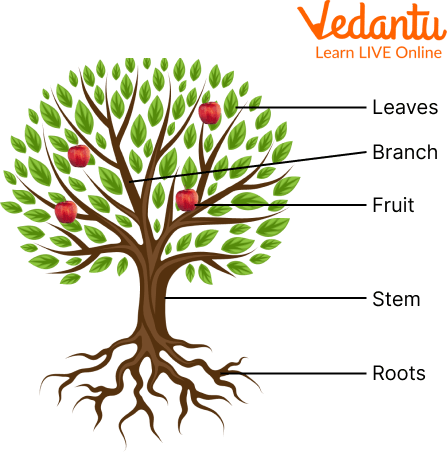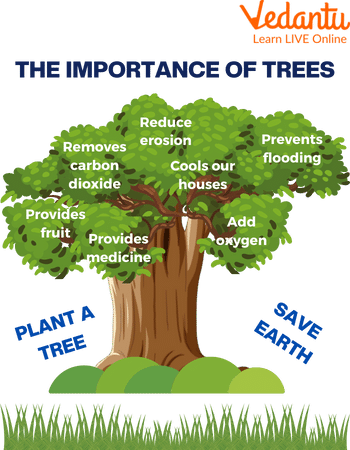




Overview of Tree
We all know what a tree looks like because they are everywhere, but what exactly makes a tree a tree? A tree has a long and thick woody bark with leaves and fruits in some. So we can say that a plant is a tree if it has a woody stem, is perennial(a plant that exists for several years), and grows to be more than 10 feet tall. Trees provide us with many things, from the air to food, shelter, and many more.
The upper part of the tree is known as a shoot which includes branches, fruits, and leaves and the lower part is the root. There are more than 80,000 different types of trees in the world! Examples of trees include Apple, Mango, Palm, etc. Here, we are going to learn more about the uses of trees for kids.

Parts of a Tree
What is a Tree?
A tree is a plant with a tall structure consisting of a stem and branches to support leaves and a root system that anchors the stem as well as procures and stores essential growth elements such as water and nutrients. Trees are unique from other plants because they can and usually do live for decades and up to several millennia (the oldest known single-stem tree is a baobab in South Africa measured to be 6000 years old), grow successive layers of woody vascular tissue that is added from growth just under the bark to develop woody stems, and in most parts of the Earth grow taller than surface vegetation, ranging in height from several meters up to 115.55 meters (the tallest recorded tree is a giant redwood in northern California).
How do Trees Grow?
When the seed falls on the ground it starts its journey to becoming a tree. It needs water to sprout and break through the soil so that it can start growing roots. Older trees expand in height, width, and depth. By generating new cells at the terminals of their branches, trees increase in height. They develop deeper into the earth as roots that draw water and nutrients from the soil. Like the tips of the branches, the roots also grow. Additionally, the trunks and branches of trees enlarge. The cambium, which is the outer layer, is where this growth occurs. Tree trunks form rings because the cambium's growth ceases in the colder months. A year of growth is represented by each ring. By counting the rings on a tree, we may determine its age.
Types of Trees
1. Conifers and Evergreens Trees
Scales or needles are the names for the stiff, slender leaves on coniferous plants. The majority of them are evergreen, which means that their leaves don't change color and fall off in the fall but instead remain green all year round. Conifers are named after the cones that contain their seed. Coniferous trees include, among others, cypresses, pines, cedars, firs, and redwoods. The tallest and biggest types of life are said to inhabit conifer trees. These are enormous redwood or sequoia trees.

Conifers and Evergreen
2. Deciduous and Broadleaf Trees
The broadleaf tree is another kind of tree. The majority of broadleaf trees shed their leaves every fall because they are deciduous. Unlike conifers, which have narrow needles, broadleaf plants have broad leaves, hence the name. Flowers are also produced by these plants. Flowers can occasionally take the shape of foods we can eat, like fruit or nuts. Oaks, beeches, maples, elms, and birches are a few examples of broadleaf trees.

Deciduous and Broadleaf Trees
Functions of Trees
Now, let’s understand more about the functions trees in our lives:
A tree's leaves are essential for capturing sunlight for photosynthesis. Photosynthesis is a process that occurs when green pigment chlorophyll in leaves captures light and uses it to make sugars which then release oxygen.
Trees give us oxygen, timber for buildings and fuel, and wood to make furniture and paper.
They also provide shade in the summertime, fixing atmospheric greenhouse gasses.
The trees help in preventing soil erosion with the help of their roots.
They also help in decreasing pollution by absorbing harmful emissions and filtering out the gasses.
They play a role in balancing the ecosystem by removing carbon dioxide from the atmosphere.
In addition, they also act as housing for different types of insects.
They absorb carbon dioxide emissions and decrease global warming.
Without trees, we would not have gasoline or paper which are very essential things.
Trees also make the environment stress-free.
Uses of Trees for Kids
A great source of fuel for cooking and stoking fires has historically been trees. A large portion of our food, including fruit and nuts, is also gathered from trees. But trees are also crucial to the environment. The main source of oxygen is trees. They take in air, which they then use to release oxygen and reduce carbon dioxide. Without trees, we couldn't survive. Additionally, trees offer us beauty and shade.

Importance of Trees
Summary
A plant or shrub that grows above ground with a trunk fixed firmly in the earth by its roots answers the question: what is a tree? From the article, tree for kids, we have also learned about trees, their features, types, and functions of trees. There are many different types of trees on Earth. Trees are of utmost importance for Humans and our environment. They provide the oxygen that we need to survive and also maintain carbon dioxide levels. Trees prevent soil erosion as the roots of trees strongly hold the soil and do not allow them to flow. Trees' natural changes have given them countless ways of helping the environment and are subject to multiple threats.
FAQs on Tree for Kids
1. What is the difference between Coniferous trees and Deciduous Trees?
The difference between Coniferous trees and Deciduous trees is that they grow in different seasons. A conifer is a broad-leaved evergreen cone-bearing tree, while a deciduous tree is one without leaves during some or all of the year.
2. How do trees help land?
Tree roots prevent soil from washing away or being blown away. Soil is made richer by leaf mold. Rainwater is absorbed by dense mats of leaves and roots on the ground, which prevent it from quickly draining into streams and rivers.
3. How can trees help relieve stress?
Trees have been proven to have a positive effect on mental health. Usual effects include less stress, decreased symptoms of depression, and improved moods.









